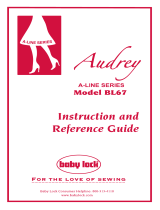
1
Thank you for purchasing this machine. Before using this
machine, carefully read the “IMPORTANT SAFETY
INSTRUCTIONS”, and then study this manual for the
correct operation of the various functions.
In addition, after you have finished reading this manual,
store it where it can quickly be accessed for future
reference.
Please read these safety instructions before attempting to
use the machine.
DANGER
- To reduce the risk of electrical shock
1Always unplug the machine from the electrical
outlet immediately after using, when cleaning,
making any user servicing adjustments mentioned in
this manual, or if you are leaving the machine
unattended.
WARNING
- To reduce the risk of burns, fire, electrical shock, or
injury to persons.
2Always unplug the machine from the electrical
outlet when making any adjustments mentioned in
the instruction manual.
• To unplug the machine, switch the machine to the
symbol “O” position to turn it off, then grasp the
plug and pull it out of the electrical outlet. Do not
pull on the cord.
• Plug the machine directly into the electrical outlet.
Do not use an extension cord.
• Always unplug your machine if there is a power
failure.
3Electrical Hazards:
• This machine should be connected to an AC power
source within the range indicated on the rating
label. Do not connect it to a DC power source or
converter. If you are not sure what kind of power
source you have, contact a qualified electrician.
• This machine is approved for use in the country of
purchase only.
4Never operate this machine if it has a damaged cord
or plug, if it is not working properly, has been
dropped or damaged, or water is spilled on the unit.
Return the machine to the nearest authorized Baby
Lock retailer for examination, repair, electrical or
mechanical adjustment.
• While the machine is stored or in use if you notice
anything unusual, such as an odor, heat,
discoloration or deformation, stop using the
machine immediately and unplug the power cord.
• When transporting the machine, be sure to carry it
by its handle. Lifting the machine by any other part
may damage the machine or result in the machine
falling, which could cause injuries.
• When lifting the machine, be careful not to make
any sudden or careless movements, which may
cause a personal injury.
5Always keep your work area clear:
• Never operate the machine with any air openings
blocked. Keep ventilation openings of the machine
and foot control free from the build up of lint, dust,
and loose cloth.
• Do not store objects on the foot controller.
• Never drop or insert foreign objects in any opening.
• Do not operate where aerosol (spray) products are
being used or where oxygen is being administered.
• Do not use the machine near a heat source, such as
a stove or iron; otherwise, the machine, power cord
or garment being sewn may ignite, resulting in fire
or an electric shock.
• Do not place this machine on an unstable surface,
such as an unsteady or slanted table, otherwise the
machine may fall, resulting in injuries.
6Special care is required when sewing:
• Always pay close attention to the needle. Do not use
bent or damaged needles.
• Keep fingers away from all moving parts. Special
care is required around the machine needle.
• Switch the machine to the symbol “O” position to
turn it off when making any adjustments in the
needle area.
• Do not use a damaged or incorrect needle plate, as
it could cause the needle to break.
• Do not push or pull the fabric when sewing, and
follow careful instruction when free motion stitching
so that you do not deflect the needle and cause it to
break.
INTRODUCTION
IMPORTANT SAFETY
INSTRUCTIONS
























